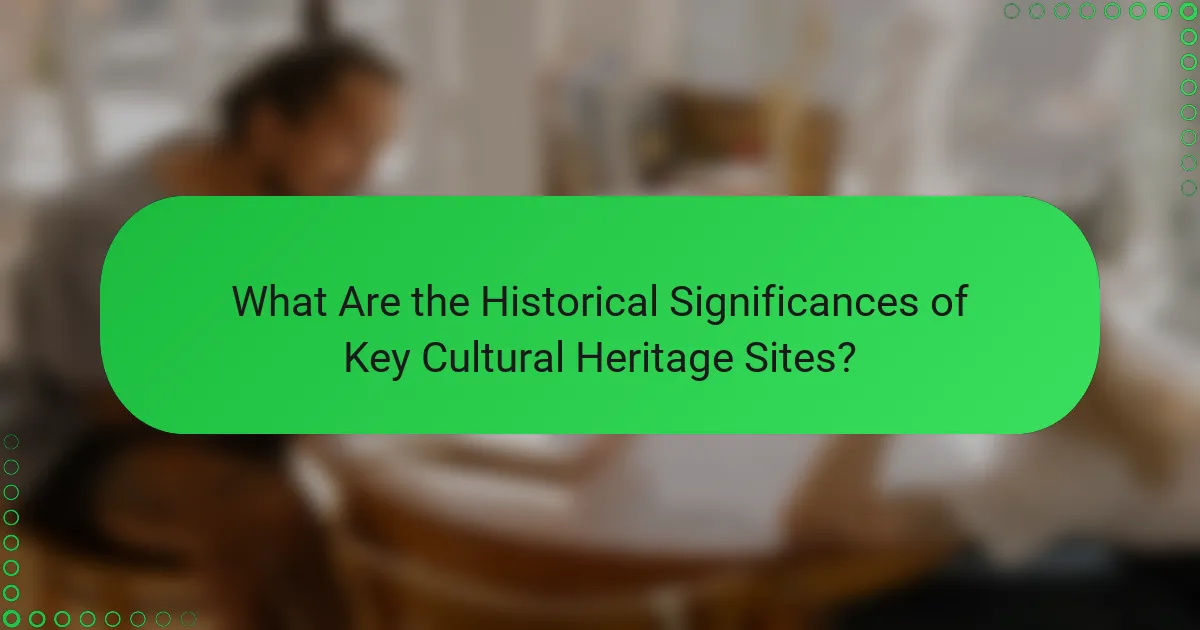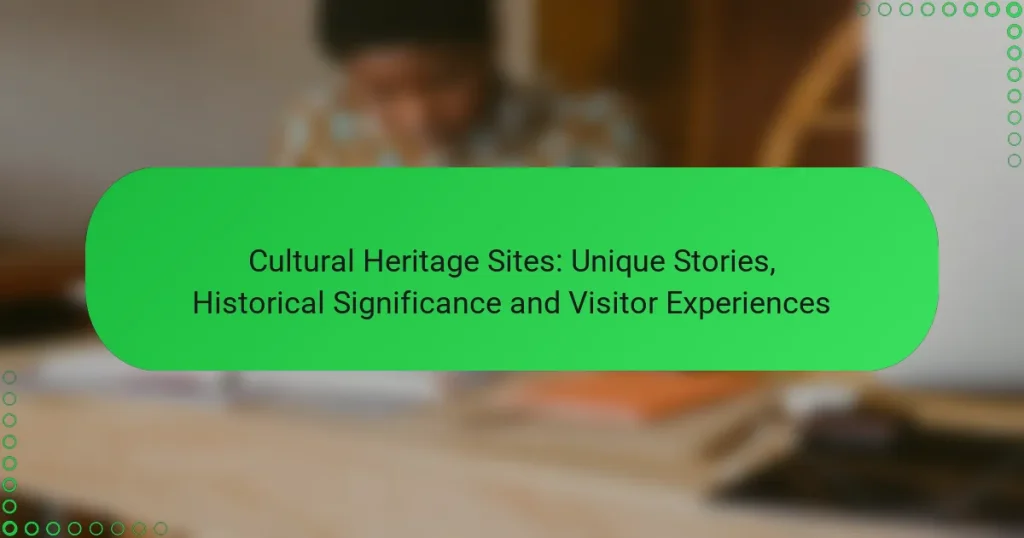Cultural heritage sites are invaluable treasures that offer visitors a glimpse into the rich tapestry of history and culture. Through immersive storytelling and engaging exhibits, these sites not only preserve the legacy of past civilizations but also foster a deeper understanding of the traditions and identities that shape communities today.

How Do Cultural Heritage Sites Enhance Visitor Experiences?
Cultural heritage sites enhance visitor experiences by offering unique insights into history, culture, and community. These sites engage visitors through immersive storytelling, interactive exhibits, and vibrant cultural events, creating memorable and educational experiences.
Immersive storytelling
Immersive storytelling at cultural heritage sites allows visitors to connect emotionally with the past. By using narratives that incorporate local legends, historical figures, and significant events, these sites create a vivid picture of the culture and history they represent.
For example, guided tours often feature actors or multimedia presentations that bring stories to life, making the experience more engaging. Visitors are encouraged to imagine themselves in different historical contexts, which deepens their appreciation of the site.
Interactive exhibits
Interactive exhibits transform passive observation into active participation, enhancing the visitor experience significantly. These exhibits often include hands-on activities, digital displays, and augmented reality features that allow guests to explore artifacts and stories in a dynamic way.
For instance, a museum might offer touchscreen interfaces where visitors can learn more about specific items or even simulate historical events. This approach not only educates but also entertains, making the learning process enjoyable and memorable.
Cultural events and festivals
Cultural events and festivals hosted at heritage sites provide visitors with a unique opportunity to experience local traditions firsthand. These events often feature music, dance, food, and crafts that reflect the community’s heritage, creating a festive atmosphere.
Participating in such events can deepen visitors’ understanding of local customs and foster a sense of connection with the culture. For example, a heritage site might host an annual festival celebrating traditional crafts, allowing visitors to engage directly with artisans and learn about their techniques.

What Are the Historical Significances of Key Cultural Heritage Sites?
Key cultural heritage sites hold immense historical significance as they preserve the legacy of civilizations, reflect architectural advancements, and narrate the stories of human experiences. These sites serve as tangible connections to the past, offering insights into cultural practices, societal values, and historical events.
UNESCO World Heritage Sites
UNESCO World Heritage Sites are recognized for their outstanding universal value and are protected under international treaties. These sites often represent significant cultural or natural heritage, attracting millions of visitors each year. Examples include the Great Wall of China and the Pyramids of Egypt, both of which showcase unique historical narratives and architectural brilliance.
Visiting these sites can provide a deeper understanding of global heritage and the importance of preservation efforts. Travelers should consider planning their visits during off-peak seasons to enhance their experience and avoid large crowds.
Architectural innovations
Cultural heritage sites often feature remarkable architectural innovations that reflect the technological advancements of their time. Structures like the Colosseum in Rome or the Taj Mahal in India exemplify the ingenuity of ancient builders and their ability to create enduring landmarks. These innovations not only serve aesthetic purposes but also demonstrate the engineering skills and materials available during their construction.
When exploring these sites, pay attention to the design elements and construction techniques that set them apart. Understanding the context of these innovations can enrich your appreciation of the site and its historical significance.
Historical narratives
Each cultural heritage site tells a unique historical narrative that contributes to our understanding of human history. For instance, the ruins of Pompeii provide insights into daily life in ancient Rome, while the Alhambra in Spain reflects the cultural fusion of Moorish and Christian influences. These narratives are crucial for interpreting the events that shaped societies and their values.
Visitors can enhance their experience by engaging with local guides or educational resources that delve into the stories behind these sites. This approach not only fosters a deeper connection but also supports the preservation of these important cultural legacies.

What Unique Stories Do Cultural Heritage Sites Tell?
Cultural heritage sites convey rich narratives that reflect the history, traditions, and identities of communities. These stories often encompass local legends, influential figures, and significant events that shaped the cultural landscape.
Local legends and folklore
Local legends and folklore are integral to the identity of cultural heritage sites, often providing a sense of place and continuity. For instance, the tale of the Loch Ness Monster in Scotland not only attracts tourists but also enriches the cultural narrative of the region.
These stories can vary widely, from mythical creatures to historical figures who are said to have performed extraordinary feats. Engaging with these legends can enhance visitor experiences, offering deeper insights into local customs and beliefs.
Influential historical figures
Many cultural heritage sites are associated with influential historical figures whose actions or legacies have left a lasting impact. For example, the birthplace of a renowned artist or a site linked to a significant political leader can provide context for understanding their contributions to society.
Visitors often seek to learn about these figures through guided tours or informational plaques, which can highlight their achievements and the challenges they faced. This connection fosters a greater appreciation for the site and its historical significance.
Significant events and milestones
Significant events and milestones often mark cultural heritage sites, serving as reminders of pivotal moments in history. These can include battles, treaties, or cultural festivals that have shaped a community’s identity over time.
For example, the site of a major historical battle may offer tours that recount the events and their aftermath, allowing visitors to grasp the broader implications of those moments. Understanding these events can deepen one’s connection to the site and its ongoing relevance in contemporary culture.

How Can Online Courses Explore Cultural Heritage Sites?
Online courses can effectively explore cultural heritage sites by providing immersive and educational experiences that highlight their unique stories and historical significance. Through various digital formats, learners can engage with these sites in ways that enhance their understanding and appreciation.
Virtual tours and experiences
Virtual tours allow participants to explore cultural heritage sites from the comfort of their homes. These tours often include 360-degree views, interactive maps, and multimedia content that showcase the site’s architecture, artifacts, and surroundings.
Many institutions offer guided virtual experiences led by knowledgeable hosts, providing insights that enrich the exploration. For instance, a virtual tour of the Colosseum in Rome might include historical anecdotes and architectural details not easily accessible in person.
Expert-led lectures
Expert-led lectures provide in-depth knowledge about cultural heritage sites, often featuring historians, archaeologists, or curators. These sessions can cover a range of topics, from the site’s historical context to its preservation challenges.
Participants can benefit from Q&A sessions, allowing for direct interaction with experts. This format fosters a deeper understanding of the significance of the site and encourages critical thinking about heritage conservation.
Interactive learning modules
Interactive learning modules engage learners through quizzes, discussions, and hands-on activities related to cultural heritage sites. These modules often incorporate multimedia elements, such as videos and infographics, to enhance the learning experience.
For example, a module might challenge learners to identify architectural styles or historical events associated with a specific site. This active participation helps solidify knowledge and fosters a personal connection to the heritage being studied.

What Criteria Should Be Considered When Choosing Cultural Heritage Sites to Visit?
When selecting cultural heritage sites to visit, consider factors such as accessibility, visitor feedback, and educational value. These criteria help ensure a rewarding experience that aligns with your interests and logistical needs.
Accessibility and location
Accessibility refers to how easy it is to reach a cultural heritage site, including transportation options and physical access for individuals with mobility challenges. Look for sites that are well-connected by public transport or have ample parking facilities.
Location plays a crucial role in your visit. Sites situated in urban areas may offer more amenities, while remote sites might provide a more authentic experience. Consider the surrounding attractions and accommodations to enhance your trip.
Visitor reviews and ratings
Visitor reviews and ratings provide insights into the experiences of others who have visited the site. Check platforms like TripAdvisor or Google Reviews for feedback on aspects such as guided tours, cleanliness, and overall satisfaction.
Look for patterns in reviews, such as consistent mentions of helpful staff or engaging exhibits. High ratings can indicate a well-maintained site, while negative feedback may highlight potential issues to consider before visiting.
Educational value
The educational value of a cultural heritage site is determined by the depth of information provided and the opportunity for learning. Sites that offer guided tours, interactive exhibits, or workshops can significantly enhance your understanding of the culture and history.
Consider whether the site aligns with your interests. For instance, if you’re passionate about architecture, look for sites known for their unique building styles or historical significance. Engaging with knowledgeable guides can also enrich your visit.


